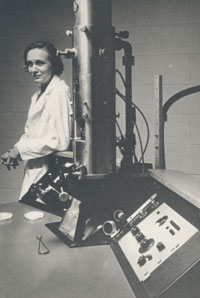Biographies
William M. Landau Memorial to Sarah A. Luse
Dr. Sarah A. Luse was a member of the Washington University School of Medicine faculty from 1954 to 1967. She was prominent in the field of neuropathology and electron microscopy, and was a professor of both anatomy and pathology. In 1967 Luse moved to New York, joining the faculty of the Columbia University College of Physicians and Surgeons. Quite suddenly, on December 28, 1970, Luse died in her sleep. Luse’s colleague, Dr. William M. Landau, professor of neurology and head of the Department of Neurology of the Washington University School of Medicine from 1970 to 1991, wrote this profile of Luse.
 |
| Sarah A. Luse, posed next to an electron microscope, ca. 1963 |
Sarah Luse, Professor of Anatomy at Columbia University, died suddenly on December 28, 1970. With Dr. Edward Dempsey she had been an early developer of the electron microscope in investigations of neuroanatomy and clinical and experimental neuropathology. Before moving to Columbia University she was Professor of Neuropathology, Professor of Anatomy, and for a time, Acting Head of the Department of Anatomy at Washington University School of Medicine. The depth and breadth of her contributions to neuropathology, and to clinical neurology and neurosurgery, are well known. Rather than expand upon these formal obituary data, I shall try to provide a more personal view of her career.
Her graduate education was delayed greatly by insufficient finances, and was achieved through hard work and well deserved scholarship aid. Early work in electroencephalography undoubtedly influenced the direction her research career would take: a dynamic rather than a static morphological view of neuropathological process. Her strong interest in the problems of general medicine and general pathology was also a deep influence.
Those who knew her in formal scientific or administrative settings were impressed with the crisp, challenging, hard-headed side of her personality. The fortunate few who came to know her more intimately realized that this facade validly represented her serious dedication to honest hard work and high standards of excellence. But they also came to recognize a delightful sense of humor which allowed her even the blessed capacity to smile at herself. Her strong objectivity would have led her to wish to be remembered only for her scientific accomplishments, but her friends will agree that her humane contributions to a generation of now accomplished protegés loom as even larger results of her scholarly dedication.
To her research trainees – and her laboratories seemed to be infinitely open to the humblest disciple who had an inquiring mind – she was a hard taskmaster, measuring their efforts by her own sixteen hour working day. She would not suffer superficiality or laziness, but any student ready to achieve her standard found her always at hand to help develop essential skills and the capacity to think critically. She knew and taught the importance of learning intimately all the methodological aspects of the work one might wish to pursue. Experienced Sarah-watchers came to recognize her graduation exercise, one which she never perceived herself: a shift from the close collaboration of tutor, to acceptance of the trainee as a mature and even competitive independent scientist.
Her teaching conferences in neuropathology were always a broad learning experience. Anyone from undergraduate students to professor might expect to be skewered by penetrating questions which peppered her extraordinarily thorough presentations of biological neuropathology. How she found time to prepare them, perform and supervise all of the surgical and autopsy neuropathology, and do superb research and teaching in two basic science departments was a mystery to her contemporaries. And besides, she was forever organizing additional voluntary and popular special seminar programs.
Least known and most admirable were her personal relationships with undergraduate students whom she knew from the beginning by her dedication to the work of the Admissions Committee. She lived in the student dormitory for many years, where, as in her laboratory office, the door was always open for counseling and advice about all kinds of problems, both personal and educational. Not a few were helped through serious crises by her advice, and not infrequently by personal loans when the problem was a financial one.
If she had any pride, it lay in projecting the image of a corn-fed, practical, common-sense, Iowa-stubborn, farm girl. The tragedy of her death in mid-career is softened by assurance that chips of that high-spirited, tough-minded, craggy character must survive in those who knew her well, and are therefore compelled to emulate her accomplishments and her style.
Related Links:
Return to WUMC Faculty/Staff (Biographies)
Return to All Biographies
Back to Top
